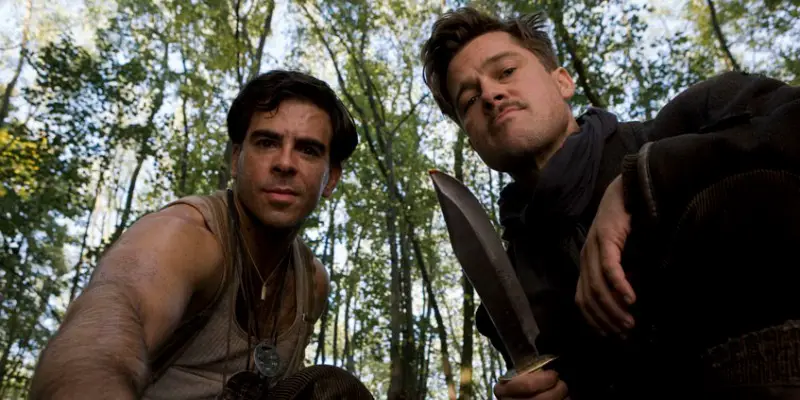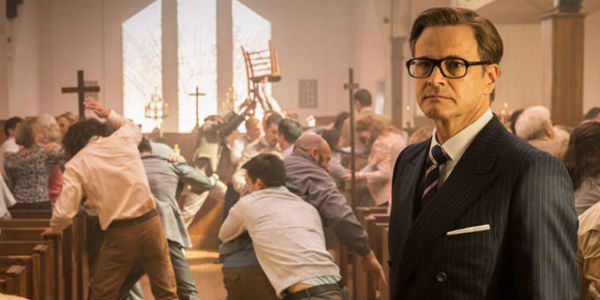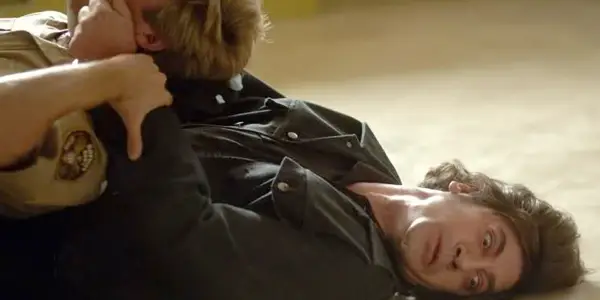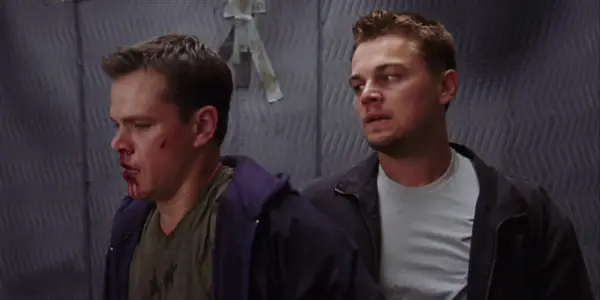10 Highly Rated Movies That Prove We’ve Become Desensitized to Violence

Jax is a filmmaker and producer, and a film &…
Violence in cinema isn’t a new concept. In fact, some of the earliest films ever made were surprisingly violent, even by todays standards. But how can we determine a desensitisation to violence in modern audiences? The Oxford Dictionary defines violence as “behaviour involving physical force intended to hurt, damage, or kill someone or something” or “strength of emotion or of a destructive natural force”.
Typically, violence is contradictory to our survival instincts and therefore should cause a negative reaction. For instance, over 100 years ago when audiences were subjected to Thomas Edison’s propaganda film Electrocuting an Elephant, they were horrified, and, as Edison intended, terrified of electricity.
As the films in this article are discussed, it is important that nothing said here be mistaken for criticism. That is, qualities of a film which may place it on this list does not equate with a film being good or being bad. Merely, it indicates a growing trend in modern society to ignore violence in media, particularly film.
While this article will concentrate largely on physical violence, because let’s face it, that is generally the argument these days (are films too violent? Is violence in films affecting our youth? And other moot points. Do we do a good job of regulating violence?), several of these films feature graphic emotional violence as well, and one would argue that could be worse to desensitise yourself to. It’s also worth noting that the term “highly rated” here is taken from public opinion, not critical opinion.
Please assume spoilers!
10. Kingsman: The Secret Service (2014)

If I’m being 100% honest, I think I’m including this film largely because of how much of a badass Colin Firth is in it. As facetious as that sounds, allow me to explain. Colin Firth kicks a lot of ass in Kingsman, without hesitation or regret. Firth usually gets cast as a soft spoken gentlemanly type and seeing him portray such ruthless physicality is both surprising and satisfying. However, the systematic militarisation of the young men and women in the film (Eggsy’s training ground) and the older generation’s (i.e. Harry’s) lack of concern for this transformation shows an ignorance and callousness to the violence necessary to complete the job at hand.
By the end of this film, our main character has grown into a man, yes, but what kind of man is he? He’s absolutely lethal! The audience is so amped up by the end of the movie (psyched up for a hopeful sequel) that they aren’t even considering the fact that this kid is totally f*cked up now. And who’s responsible? Colin Firth! Seriously, the dude from Pride & Prejudice is personal responsible for likely PTSD and we as an audience just don’t give a f*ck.
9. The Avengers (and The Marvel Franchise) (2012, 2015)

Unsurprisingly, we include superhero films (and there will be more). Why? Well, death tolls have steadily risen in superhero action films, but Marvel films have taken a particularly lethal slant. The combined death toll attributed to The Avengers members over the course of their films is at least 200. Compare that with Superman’s one kill and Batman’s code of honour in DC films. Doesn’t look great, does it? But Marvel films generally perform high and above DC, despite the death discrepancy. Clearly, modern audiences aren’t put off.
Marvel does have the redeeming quality of making an effort to show the effects of a life of violence on these characters. Not a single one them is what you could call “well-rounded”; Tony Stark struggles with alcoholism, Bruce Banner maintains a life of solitude, Black Widow is irreparably damaged. This attempt lands The Avengers and its brethren films at the bottom of this list.
8. No Country For Old Men (2007)

The Coen Brothers’ quiet drama put Javier Bardem on the map of the English speaking world for his portrayal of Anton Chigurh, a moralless bounty hunter. As he chases Josh Brolin’s Llewelyn Moss across state lines towards Mexico, he leaves behind a trail of bodies. His lack of remorse chills the viewer to the bone and his ability to track Llewelyn creates the feeling that he may be more than human. “Lack of remorse” doesn’t quite capture it. Chigurh simply doesn’t care. You live or you die. Those are just the two possibilities. He carries out your fate, but he doesn’t choose it.
When you really consider the film, it’s f*cking terrifying. I think I had trouble sleeping after I saw it for the first time. I really don’t know how the Coen Brothers went from making this to Burn After Reading, because I find No Country For Old Men emotionally taxing. Death waits for us all and Death shows no mercy and no regret. Death murders you with an airgun.
7. The Departed (2006)

Martin Scorsese’s gritty remake landed itself a nice tidy spot here. Why? Firstly, literally everyone dies and dies badly. Few endings are more shocking or more bloody. Secondly, the journey to said ending brings the viewer through some pretty horrific acts of violence. One that particularly stands out is Jack Nicholson beating Leonardo DiCaprio’s already broken hand with a shoe. Please stop for a moment and consider those two things and then consider that at the end of this movie, the audience in the theatre I was in applauded.
Don’t get me wrong, the film was fantastic – certainly worthy of an Oscar nod (though I think the win should’ve gone to Eastwood that year for Letters From Iwo Jima). However, after a film like that, I don’t think viewers should’ve been so jacked up. This was a hard film about hard people, living violent as f*ck lives. What does it say about us that this doesn’t seem to bother audiences?
6. A History of Violence (2005)

Many of David Cronenberg’s films could’ve easily found their way to this list, but A History of Violence is special. Not only does the plot follow one of Cronenberg’s most straightforward narratives, the film contains some of his more brutally violent scenes. Ultimately, the most destructive and terrifying character of all is our protagonist, who’s very nature seems predisposed to a life of violence. Despite witnessing him commit some very bloody acts, Cronenberg deftly constructs a sympathetic view of Viggo Mortensen’s character, Tom, and successfully vilifies Ed Harris and William Hurt.
Would that this were not fiction, do you really think it’d be that simple? By the end of the film, Tom has his family back – tenuously or not, they are there – and everyone else is dead. If my husband went on a murderous rampage and came home neither myself nor my children would be within 500 miles. But in our suspension of disbelief, somehow this works and this is what we, as an audience, have been craving. Like many of Cronenberg’s films, the final note leaves the audience questioning their own morals (or at least, it should). But that was the point, as Cronenberg himself said in this interview with The Telegraph:
“I’m not surprised the audience would applaud the violence,” he says. “I wanted them to be complicit in it, then to think after the movie, how they feel about their complicity? If [violence] is done in such a way that the audience is repulsed, I’ve lost the opportunity to deliver to them the paradox of enjoying something they find morally reprehensible. I’m sure those who were applauding are not people who have killed other people, so what is it to them that’s attractive? That’s one of the themes of the movie.”
5. Inglourious Basterds (2009)

Come on, you knew Quentin Tarantino was going to show up somewhere on this list. Honestly, I had a bit of trouble choosing which Tarantino film to choose. I decided on previous article of mine. It’s no secret that Tarantino embraces a love of ultra violence, as do the characters in the Tarantino film universe (or one should say both Tarantino film universes). That ultra violence stems from the proceedings of Inglourious Basterds. And here’s the thing, not only are we, the audience, totally fine with that, we actively cheered it on.
If you saw this in theatres, I’m willing to put money on the fact that during the scene when Donowitz and Ulmer gunned down Hitler in the cinema there was actual applause and/or whooping. It’s completely understandable; it’s the classic time travel question. Would you, given the chance, kill Hitler? Well, Tarantino did and he’s given us his alternate version of unfolding events with his films and they are bloody, violent, gritty, and beloved.
4. Mad Max: Fury Road (2015)

The Mad Max universe has always been a violent one, a dystopian future where resources are limited and people return to tribal warfare to survive. Mad Max: Fury Road continues this theme, showing a civilisation which controls its populace through control of precious resources, namely water, breeding, and brainwashing. Because we’ve taken our characters and placed them in extraordinary circumstances where they must fight to survive, as an audience we forgive violent acts more readily than we might otherwise.
While Max ultimately makes “moral” choices, his actions are survivalist and therefore quite selfish and often violent. Would we forgive this character for pulling a gun on Charlize Theron if the situation were slightly different? My point is, because of the world of the story, we don’t even consider the violent acts of the film, we merely accept them as part of the functionality of this world.
3. Kick-Ass (2010)

When Kick-Ass came out, a lot of discussions happened about how violent the film was. The film was extremely graphic. But I want to draw particular attention to the character of Hit Girl. We watch this pre-teen murder several men and dust it off as no big deal. She’s a tiny little psychopath and shouldn’t be celebrated as “bad ass” or “awesome” but “terrifying” and “tragic”.
The sheer amount of Hit Girl cos players points to proof that this doesn’t strike home for many viewers. An 11 year old, future psychiatric ward resident has been taken by the viewers and not only lauded, but sexualised. This is my plea: stop this.
2. The Girl With The Dragon Tattoo (2009, 2011)

So for clarity, we’re discussing both the original Swedish-language version of The Girl With the Dragon Tattoo as well as the remake by David Fincher. These films differ from the rest on the list because the nature of the violence featured is almost exclusively sexual. I think audiences were appropriately shocked and horrified by the terrible acts commited by the male offenders. However, what I found amazing was the forgiveness shown towards the lead female character, Lisbeth.
While her acts are more justified, they are just as horrific. Personally, I couldn’t continue to see her as a protagonist and I was extremely surprised to find myself very much alone in this. Is this some perverted form of sexism? That because she’s a woman and raped a man it’s not the same? If this was a real world situation, you wouldn’t condone a rapist, regardless of their reasoning. But put it on a screen, suddenly we can get behind it?
1. Transformers (2007)

Anyone who’s discussed the subject with me knows I’m not a huge Michael Bay fan, to put it politely. I enjoy one or two of his films, but for the most part I find his films to be action-packed but storyless. The Transformers quadrilogy (at the time of writing) exemplifies this more than any other of his films. Endlessly popular movies, they’re full of more violence than I think any other film on the list.
How do I mean? Remember, violence is “behaviour involving physical force intended to hurt, damage, or kill someone or something” and that is literally the plot of these films, every time, regardless of whether you’re talking about Decepticons or Autobots. However, since I’ve only really seen the first and third Transformers films, I’ve limited my discussion to the first film.
The Transformers lead the main characters down a path of mayhem, destruction, and bloodless killings. They barely even stop to consider later the bots that get literally ripped apart and presumably the countless innocent civilians caught in the wake of all the destruction and kaboom-ing. So we’ve taken a teenage protagonist and turned him into a soldier. There are charities you can donate to that help stop that sort of thing in real life.
The reason I really have a problem with this though is that there is absolutely no effect of all this violence on any of the characters. They’re totally fine and that’s the message that we are showing to children, because remember this is a PG-13 movie. And I happen to agree with what Kevin Smith discusses in This Film Is Not Yet Rated – that our ratings system is backward and films which show lots of blood, death, and the real gory effects should be the ones to get PG-13 and the films, like Transformers, that don’t show a realistic presentation of violence should be R.
I think that violence, sometimes even graphic violence, serves a purpose in film. It can highlight a crucial truth, such as the nature of a character, or perhaps contrast against non-violence (like in Pan’s Labyrinth). What’s important is that we as an audience acknowledge that it’s violent and react appropriately. A Clockwork Orange was banned from playing for years because of the violence. I think that’s an extreme reaction, but at least it’s a reaction. I prefer that to no reaction whatsoever.
It seems that filmmakers need to push the envelope further and further. One day that envelope will get pushed too far and it will be the same people who think showing kids buildings full of people blowing up is fine as long as you don’t actually see the people who complain.
Do you think viewers are desensitized to violence or am I overreacting? Tell me in the comments!
Does content like this matter to you?
Become a Member and support film journalism. Unlock access to all of Film Inquiry`s great articles. Join a community of like-minded readers who are passionate about cinema - get access to our private members Network, give back to independent filmmakers, and more.
Jax is a filmmaker and producer, and a film & tv production lecturer at the University of Bradford and is also completing a PhD about Stan Brakhage at the University of East Anglia. In the remaining "spare time", Jax organises the Drunken Film Fest, binges bad TV, and dreams of getting “Bake Off good” with their baking.













